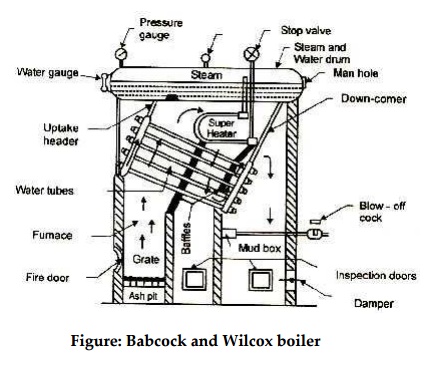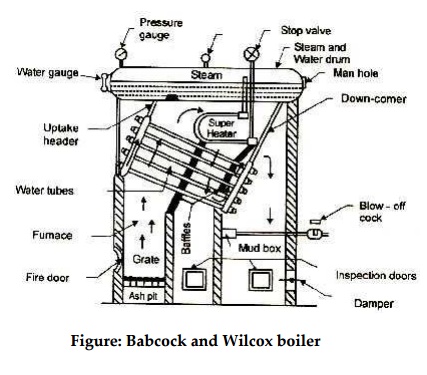Chapter: Mechanical and Electrical : Power Plant Engineering : Coal Based Thermal Power Plants
Water Tube Boilers: Babcock and Wilcox boiler

Water Tube Boilers: Babcock and Wilcox boiler
It is a water tube boiler used in steam power plants. In
this, water is circulated inside the tubes and hot gases flow over the tubes.
Description:
The Babcock and Wilcox boiler
consists of
1.
Steam
and water drum (Boiler shell)
2.
Water
tubes
3.
Uptake
–header and down –comer
4.
Grate
5.
Furnace
6.
Baffles
7.
Superheater
8.
Mud
box
9.
Inspection
doors
10.
Damper
1.
Steam and Water drum (Boiler Shell)
One half of the drum which is horizontal is filled up with
water and steam remains on the other half. It is about 8 metres in length and 2
metres in diameter.
2.
Water tubes
Water tubes are placed between the drum and the furnace in
an inclined position (at an angle of 100 to 150) to
promote water circulation. These tubes are connected to the uptake –header and
the down –comer as shown.
3.
Uptake –Header and Down –comer (or Down take –Header)
The drum is connected at one end to the uptake –header by
short tubes and at the other end to the down –comer by long tubes.

Figure: Babcock and Wilcox boiler
Grate:
Coal is fed to the grate through the
fire door.
Furnace:
Furnace is kept below the uptake
–header.
Baffles:
The fire –brick baffles, two in
number, are provided to deflect the hot flue gases.
Superheater:
The boiler is fitted with a superheater tube which is
placed just under the drum and above the water tubes.
Mud
box:
Mud box is provided at the bottom end of the down –comer.
The mud or sediments in the water are collected in the mud box and it is blown
–off time by means of a blow –off cock.
Inspection
doors:
Inspection doors are provided for
cleaning and inspection of the boiler.
Working
principle:
Coal is fed to grate through the fire
door and is burnt.
Flow
of flue gases:
The hot flue gases rise up ward and pass across the left
–side portion of the water tubes. The baffles deflect the flue gases and hence
the flue gases travel in a zig –zag manner (i.e., the hot gases are deflected
by the baffles to move in the upward direction, then downward and again in the
upward direction) over the water tubes and along the superheater. The flue
gases finally escape to the atmosphere through the chimney.
A continuous circulation of water from the drum to the
water tubes and water tubes to the drum is thus maintained. The circulation of
water is maintained by convective currents and is known as ‚natural
circulation‛.
Superheating:
Steam is taken from the steam space of the drum through a
tube to the superheater. Steam is superheated in the superheater, as it
receives additional heat.
A damper is fitted as shown regulate
the flue gas outlet and hence the draught.
The boiler is fitted with necessary mountings. Pressure gauge
and water level indicator are mounted on the boiler at its left end. Steam
safety valve and stop valve are mounted on the top of
the drum. Blow –off cock is provided for the periodical
removal of mud and sediments collected in the mud box.
Salient
features:
1.
Its
overall efficiency is higher than a fire tube boiler.
2.
The
defective tubes can be replaced easily.
3.
All
the components are accessible for inspection even during the operation.
4.
The
draught loss is minimum compared with other boilers.
5.
Steam
generation capacity and operating pressure are high compared with other
boilers.
6.
The
boiler rests over a steel structure independent of brick work so that the
boiler may expand or contract freely.
7.
The
water tubes are kept inclined at an angle of 100 –150 to promote water circulation.
Water
tube boiler over fire tube boilers:
Advantages:
1.
Steam
can be generated at very high pressures.
2.
Heating
surface is more in comparison with the space occupied. In the case of water
tube boilers.
3.
Steam
can be raised more quickly than is possible with a fire tube boiler of large
water capacity. Hence, it can be more easily used for variations of load.
4.
The
hot gases flow almost at right angles to the direction of water flow. Hence
maximum amount of heat is transferred to water.
5.
A
good and rapid circulation of water can be made.
6.
Bursting
of one or two tubes does not affect the boiler very much with regard to its
working. Hence water tube boilers are sometimes called ‚safety boilers‛.
7.
The
different parts of a water tube boiler can be separated. Hence it is easier to
transport.
8.
It
is suitable for use in steam power plants (because of the various advantages
listed above).
Disadvantages:
1.
It
is less suitable for impure and sedimentary water, as a small deposit of scale
may cause the overheating and bursting of tubes. Hence, water treatment is very
essential for water tube boilers.
2.
Maintenance
cost is high.
3.
Failure
in feed water supply even for a short period is liable to make the boiler
overheated. Hence the water level must be watched very carefully during
operation of a water tube boiler.
Related Topics